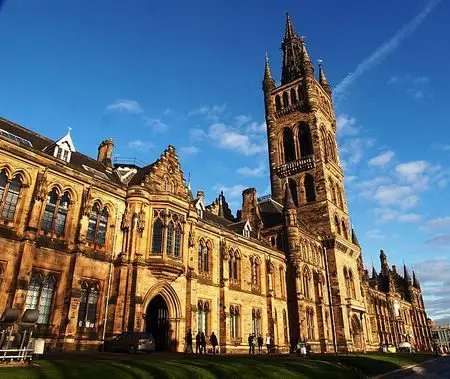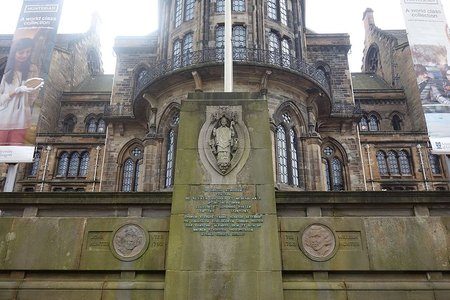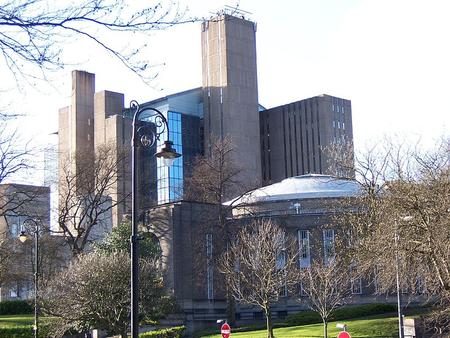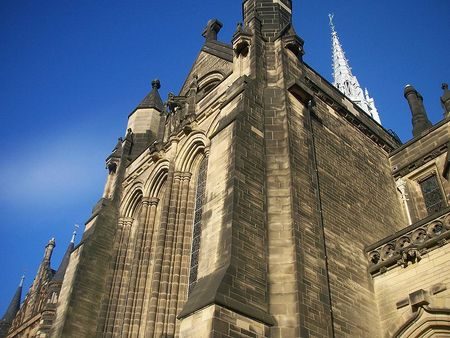As you walk through the Kelvingrove Park, spires of an astonishingly beautiful building spring into view. Passers-by will tell you that it is the south front of the Glasgow University though the look decidedly belongs more to a medieval castle. One of the most prestigious and architecturally beautiful universities in the world, Glasgow University was founded in 1451 by Bishop Turnbull and King James II. This is technically the 4th oldest university of the western world and the 2nd oldest in Scotland. The university is a member of the respected Russell Group that’s a group of leading British institutions involved in research and teaching.
Glasgow University has rewarded the world with James Wilson (founder of USA), engineer James Watt, Adam Smith (economist), Lord Kelvin (physicist), Joseph Lister (surgeon), 7 Nobel Prize winners and 3 prime ministers. The first women medics of Scotland trained at the Glasgow University under the tutelage of Isabella Elder.
Anyone who visits the Glasgow University and has seen the Harry Potter movies will be struck at the degree of semblance between the main University building and Hogwarts. In fact, the University courtyard is uncannily similar to the spot where Harry first learned to fly his broomstick.

History
In 1451, King James II sent a charter/ papal bull to Bishop William Turnbull instructing the addition of a university to the City’s cathedral i.e. Glasgow Cathedral. The Bull therefore remains as a symbol on the degrees awarded by the Glasgow University. Teaching at the University started at the Glasgow Cathedral chapterhouse and then moved into a building on Rottenrow…done up in the beautiful Scottish Renaissance style. Soon the building proved too small for the expanding operations of the university and around 1870 the entire university was moved to the verdant hilly landscapes of Gilmorehill (this is now Glasgow’s buzzing West End).
The main façade of the university and other aesthetically important parts like Lion and Unicorn Staircase were also transferred. Today, the university is spread over a number of Campuses though when a tourist visits Glasgow the focus is usually on touring the Gilmorehill campus as it’s architecturally and historically the most magnificent and hosts the major chunk of the famed Hunterian Collection.
Apart from the Gilmorehill campus there is the Veterinary school and Observatory at the Garscube Estate in Bearsden and Mental Health and Well Being section at Gartnavel Royal Hospital on Great Western Road along with the Learning and Teaching Centre on Queen Elizabeth University Hospital and the Crichton campus in Dumfries
What to See and Do
The Glasgow University Gilmorehill campus is famed for its architectural beauty and historical value. The most prominent attractions of the campus are as follows:
Glasgow University Gates
You can enter the university by the Main Gate that lies to the west…this is the oldest and most visually striking gate designed by Burnett. The Library Hall and the Hunter Memorial are the most accessible through this gate. The Memorial Gates are to the East…they pay tribute to the 29 famous personalities associated with the University.
The Memorial Gates were built in 1952 and celebrate the first 500 years completion of the University besides honouring the 29 Luminaries who passed out of it. Just outside the gates there is University Avenue and the Memorial Garden that pays tribute to those who perished in the First World War. Then there is the Hunter Memorial that was built to honour student and founder of the Hunterian… William Hunter (a famed anatomist) and his brother John Hunter.

The north front of the University has two entrances on either end of the John Burnett building in English Gothic style. The University architecture deserves a lot of admiration so spend some time looking around at the main features even if you don’t take a guided tour.
Main Building/ Gilbert Scott Building
The main building is often referred to as ‘The Gilbert Scott’ and it’s the outline of this that you can view from the Kelvingrove Park. The main doorway of the Gilbert Scott building has a plaque proclaiming ‘Via Veritas Vita’ i.e. the way, the truth, the life. This is the motto of the University. The university tower is immensely photogenic and at 278 feet of height…this is one of Glasgow’s most loved landmarks. The arched windows flank the concert hall of the University and hosts a weekly concert during term time. Most of the Hunterian Museum Collection is also hosted in the main building Level 4. The Gilbert Scott has photogenic archways on both sides. The lift is under the west archway but it’s recommended to climb the stairs so that you can have a closer look at the building.
Sir Gilbert Scott designed the Glasgow university Gilmorehill campus building though the imposing tower and spire were added later by John Oldrid Scott (Gilbert Scott’s son) in 1887 to 1891. The entire building is made of local stone with detailing of Kenmure Freestone and there are striking columns made of red sandstone and pink granite. The design attracted a lot of controversy in its time as Sir Gilbert Scott fused together the Gothic and Victorian Scottish styles.
In case visiting the 10,000 exhibit rich Hunterian Collection is your main objective then most of your time will be spent inside the Gilbert Scott. The Hunterian Museum and the Mackintosh House are two of the major attractions of the University and you can read about them in detail here.
University Flagpole
The University Flagpole offers great views of the city and you can see the Kelvingrove Park and Kelvingrove Art Gallery and Museum in the distance. If you look right you can see Kelvin Hall… that’s a collaborative project between the University, National Library of Scotland, Hunterian Museum and the City of Glasgow… on a clear day you will be able to admire the stunning architecture of the Clyde auditorium, Scottish Event Campus and SSE Hydro that sits on the waterfront of the Clyde River.
Lord Kelvin’s House
Did you know that Lord Kelvin was the youngest as well as the oldest registered student at the Glasgow University? He first registered at the University when he was 10 years and then again when he was 75. The Lord Kelvin House inside the Glasgow University Campus served as Lord Kelvin’s home from 1870 to 1899. Incidentally, it was amongst the world’s first houses to be entirely lit up by electricity. Lord Kelvin was famous for his work on the temperature scale (known as Kelvin scale), transatlantic telegraph, Kelvin Compass and the sounding machine.
Welcome Point
The Welcome Point is the visitor information centre (right next to the University Main Gate) based in McIntyre building. The Welcome Point is usually open from 9.00 a.m. to 5.00 p.m. on weekdays (opens a little late on Mondays and closes a little early on Fridays). This building was designed by Sir John James Burnet in 1880’s and was once the site hosting University Men’s and Women’s Unions. Look out for the red telephone boxes besides the building…pure British style designed by Sir Gilbert Scott. You will get information booklets about the University, Hunterian collection, tour tickets and floor plans from here.
East and West Quadrangles
They are two extremely pretty parts of the campus that host the Graduation Day celebrations including a Kilted Piper led procession. Incidentally, Glasgow university students are forbidden to walk across the grass of this area before they graduate…its considered bad luck!!! The Quadrangles are home to lecture theatres and the Adam Smith Business School.
University Library
The University Library is on the Hillhead Road that’s opposite to the main building. It has 12 floors which are home to more than 3 million books and journals and about 52,000 electronic journals. Periodicals, rare materials, microfilms and special collections are also housed here. There are special subject libraries for chemistry, medicine, dental science and veterinary science, education, social science, law etc. There is also a separate section funded by the Wolfson Foundation that hosts the university’s collection of historic photographs. The University of Glasgow archives are famous for their depth and range…the archives were created and maintained since 1451.

Members of the public are given access to the University Library only if they collect a Day Pass. You can check this link to see whether you are eligible for the library Day Pass. Alternatively, you can email [email protected]
Professors Square
Sir Gilbert Scott designed the 13 terraced townhouses that were originally meant to be residences of University professors. These are now used as college offices, teaching spaces for Theology and administrative purposes.
Cloisters
The graceful arches called Cloisters have fluted columns and walls with transverse ribs… they are also known as the Undercroft. They connect the Eastern and Western quadrangles and will take you into the famed Gilbert Scott building. The lovely Bute Hall that hosts the graduation ceremonies of the university and the Hunterian Museum are also connected by the Cloisters. The movie Cloud Atlas and Outlanders featured the Cloisters prominently.
Lion and Unicorn Staircase
The Lion and Unicorn Staircase was created in 1690 by stonemason William Riddel and was part of the original building on High street. When the university shifted to the Gilmorehill campus, the staircase was deconstructed and brought to the new location stone by stone by horse cart and then rebuilt and assembled in the exact same way. Incidentally the Lion is UK’s national symbol while the Unicorn is the national animal of Scotland. You will find these stairs near the Memorial Chapel and they are a good place to get a vantage view of the campus.
Memorial Chapel
The University of Glasgow Memorial Chapel was created on 4th October 1929 by Sir John James Burnett and pays tribute to the erstwhile students and staff of Glasgow University…especially those who died in the First World War. The Memorial Chapel is a Category ‘A’ listed building and is located in the western quadrangle of the university main building. The chapel isn’t too large but its James Burnet created design is beautiful and it has a series of 10 stained glass windows and graceful wooden stalls and carvings. Tablets on the wall behind the Table of Communion list the name of those who died in the world war.

The best thing you can do on the Glasgow University Campus is to walk around with a good camera in your hand and try to capture all the architectural brilliance you are exposed to. The buildings are all very old but nicely maintained and with that distinct Hogwarts touch about them. There are plenty of green spaces too…lawns with big shaded trees and flowers in bloom. You can simply sit on the grass and ponder or make a beeline for the gift shop and the numerous cafes on the campus.
University Gift Shop
The university gift shop is a nice place to shop for University of Glasgow merchandise and their collection of traditional tartans and a range of jewellery and clothing. There are also a lot of stationery, books, sweets and accessories in the Gift shop…all locally sourced. Look out for the scale model of the University outside the gift shop…it has a bird’s eye view of the Gilmorehill Campus and it surrounding architecture.
University Restaurants and Cafes
There are plenty of dining options inside Glasgow University….visitors are usually spoilt for choice
The Food for Thought Café (Fraser Building Level 2) serves some hot meals (including vegan and vegetarian ones) and can seat 400 people. It’s open from Monday to Friday from 11 a.m. to 3.00 p.m.
Food to Go is on Level 3 Fraser building and is open from Monday to Friday (8 a.m. to 6.30 p.m.). You will get sandwiches, pizzas, Panini’s, noodles, and some other snacks items here.
One A The Square Café is open from 10 a.m. to 4.30 p.m. on weekdays. They serve a good range of speciality tea and coffees plus soya milk beverages, fair trade hot chocolate and lattes.
One A the square Brasserie is open from 8 a.m. to 2.30 p.m. every weekday and is great for a hearty breakfast!! You will get baked potatoes, warm baguettes, vegan dishes, tasty desserts and a nice range of speciality coffees and teas. This place can seat about a 100 people and offers brasserie style meals too.
Atrium Café is in Wolfson Medical Building and its open from 8.30 a.m. to 4.00 p.m. from Monday to Friday. It can seat about 80 people and offers baguettes, confectionary, sandwiches, bakes and soups apart from beverages.
Café Piccolino is in the Boyd Orr Building and its famous for its special Sumatran Coffee blend…named Orang Utan. They serve salads, soups, snacks and sandwiches and are open from 8.30 a.m. to 3 p.m. every weekday.
University Library also offers café service on Monday to Thursday (8 a.m. to 8 p.m.)
Concerts and Exhibitions
Every Thursday during Term time, a concert is arranged on the University Campus during lunch time. Then there are Organ Recitals in the University Chapel and exhibitions in the different buildings. Some of these events will have paid entry while others are free. For a complete list of events and their timings check this link.
Guided Campus Tours for Visitors
Guided Tours for the university (called University of Glasgow Historical Tours) are offered and they sensitise visitors to the architecture of the University and its centuries old history besides providing information and anecdotes about its illustrious alumni like Adam Smith, William Hunter, James Watt, Joseph Lister etc. Hour long Campus tours for visitors are arranged by Student Representative Council (SRC) and conducted by trained student guides. Tours are offered from Tuesday to Sunday and they can be booked in advance by clicking this link.
Or else you can buy tickets from the SRC Welcome Point in McIntyre Building or from any one of the tour guides. The offices are open from Monday to Friday (9 a.m. to 5.00 p.m.). The ticket prices are 10 pounds per adult and 25 pounds per family (2 adults and 2 kids). For teens under 18 the tickets cost 5 euros while for kids under 5 there are free tickets. From April to October there are 2 tours ….departing at 11 a.m. and 2 p.m. while from October to April there is only one tour that departs at 2 p.m. Tours are organised from Tuesday to Sunday.
You can do a self-guided tour of the Glasgow University any day (8 a.m. to 5 p.m.). Many sections of the University are closed in the weekends but you can still walk around if admiring the buildings is your only objective.
Groups of more than 8 in number can contact in advance to arrange special guided tours.
Phone: 0141 330 5360; Email: [email protected]
Watch the Glasgow University tour preview here
Location & Contacts
You can walk to the Glasgow University Gilmorehill campus from the city centre in 20 to 30 minutes. The closest subway is the Hillhead station and the bus service 4/ 4 A will take you to the University Avenue from the city centre. The nearest train station is Patrick that’s 20 minutes away. Most hop on hop off Glasgow city tour buses also stop in front of the University campus. There are multiple entrances to the Glasgow University but walking in through the Memorial Gates is recommended as it pays tribute to the university alumni and staff who perished in the First World War.
There are multiple cafes and restaurants inside the campus so venturing out for snacks or beverages is really not needed. If the intriguing intellectual and aesthetic atmosphere of the Gilmorehill Campus charms you (and it will) then you might think of visiting the Glasgow University South i.e. the Dumfries Campus (part of the Hunterian collection is also housed here) that offers degrees in liberal arts.
Once you are done taking the University Historical tour or doing a self-guided tour of the campus, you can delve into the Hunterian Collection. And if you are done with both of these then the nearby Kelvingrove Park is a good place to unwind and chill afterwards.
The Glasgow University Campus is moderately accessible and they have a lot of provisions for the visually impaired and spatially challenged. Information booklets in Braille are available and wheelchairs are available for visitors from the Main Gate. To check the availability of accessibility aids call Main Gatehouse – 0141 330 444.
University of Glasgow, Gilmorehill Campus, Glasgow G12 8QQ
Phone: 44 141 330 2000; Email: [email protected]; Website
 A travel addict. Still celebrating the day when he quit his high-profile corporate job to pursue his passion for travel writing.
A travel addict. Still celebrating the day when he quit his high-profile corporate job to pursue his passion for travel writing.